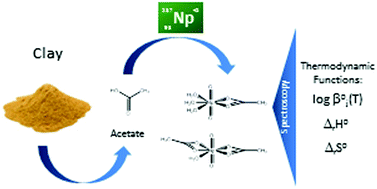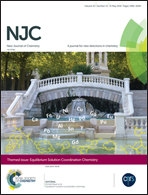The complexation and thermodynamics of neptunium(v) with acetate in aqueous solution†
Abstract
The complexation of NpO2+ with acetate is studied in aqueous solution by absorption spectroscopy as a function of the total ligand concentration (NaAc), ionic strength (Im = 0.5–4.0 mol kg−1 Na+(Cl−/ClO4−)) and temperature (T = 20–85 °C). Three distinct Np(V) species (NpO2(Ac)n1−n; n = 0, 1, 2) are identified, and their molar fractions determined by peak deconvolution of the absorption spectra. With increasing temperature the molar fractions of the higher complex species increase. The conditional stability constants log βj′(T) are calculated for each temperature and extrapolated to IUPAC reference state conditions (Im = 0) using the specific ion interaction theory (SIT). The log β0n(T) values increase by approximately 0.4–0.5 logarithmic unit for NpO2(Ac) and by about 0.5–0.6 for NpO2(Ac)2−. Furthermore, the thermodynamic stability constants are linearly correlated with the reciprocal temperature. Thus, fitting the data according to the integrated Van’t Hoff equation yields the standard reaction enthalpy ΔrH0 and entropy ΔrS0 for the complexation reactions. Both complexation reactions are endothermic and driven by the entropy. In addition, the SIT specific binary ion–ion interaction coefficients of the complex species with Na+/ClO4− and Na+/Cl− (εT(i,k)) are determined as a function of temperature.

- This article is part of the themed collection: Equilibrium Solution Coordination Chemistry


 Please wait while we load your content...
Please wait while we load your content...